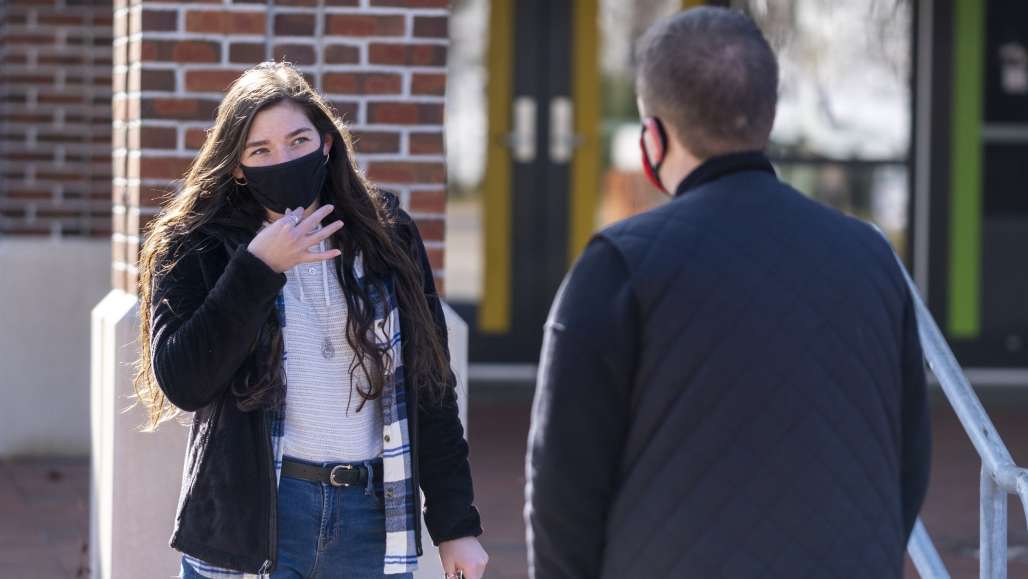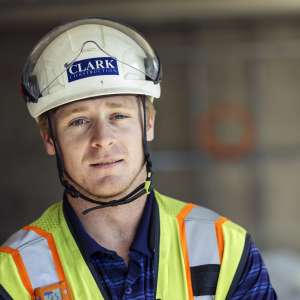Safety Interns Work on Protection Program to Keep Keene State Safe

The Keene State COVID-19 Protection Program is providing Keene State with valuable information to keep the community safe while giving motivated student interns a chance to apply what they’re learning to a real-world scenario. The program is a strategy to monitor and protect the campus community from a potential virus outbreak while in-person classes are held. Because the virus can be spread through the air, interns from the Safety and Occupational Health Applied Sciences Department use instruments to measure carbon dioxide levels and particulate levels in classrooms to assess air quality there. In addition, they monitor COVID-19 employee attestation reports required by the NH governor, covid training participation, and mask usage on and around campus.
The overall program was developed by Ralph Stuart, Keene State’s environmental safety manager, using the PLAN DO CHECK ACT model to structure the program. Ralph explained, “I have experience both at Cornell University and at the University of Vermont in building these kinds of systems. The idea behind the safety management PLAN DO CHECK ACT model is to improve things over time continuously. At the end of the semester, we’ll look at the numbers we’ve gathered and decide whether to keep the same measurements or come up with something else to measure for the spring semester.”
Ralph leads the research group, which is comprised of three student interns: Megan Ferm, Kristen Perras, and Sean Trodden. All three students are senior safety and occupational health sciences majors. While paid for their work, they’re also gaining valuable experience and the opportunity to work alongside an expert in the safety field.
Megan’s focus is on situational awareness, the “PLAN” step of the project. She works on monitoring who and how many individuals have completed the health attestation form and the number of individuals completing the online COVID-19 awareness and management training.
The “DO” step is physical distancing. To achieve this in the classrooms, the occupancy limits have been reduced to 38% of the spring 2020 level across campus. Sean and Ralph work together to monitor carbon dioxide levels in different classrooms. The level of CO2 detected in the air indicates the occupancy situation of the room. They periodically move the monitors to new classrooms, scrutinizing their findings to ensure professors and students are working in a safe environment. With a New England winter approaching, Sean and Ralph have to stay vigilant. They expect the CO2 levels to rise as the temperature lowers. “Now the weather is getting colder, we expect people to close the windows more. There’ll be less fresh air coming into the space, so CO2 levels are likely to go up,” said Ralph. If these levels reach levels of concern, discussions with the KSC Covid-19 Planning group will help identify ways to address this issue.
“CHECK,” the third step, monitors whether or not the safety management plan is making a difference. Sean and Ralph monitor indoor air quality by tracking the number of particles in the air, and utilize High Efficiency Particulate Air (HEPA) filters that collect dust and particles out of the air that passes through it. They strategically placed about 100 of these into both classrooms and offices around campus in areas where multiple people are likely to spend extended periods of time. To check if what they’re doing is working, Sean and Ralph monitor the air particulate levels. “We’re tracking particulate levels to see if there are any trends that indicate that our classrooms are cramped, too crowded, or not getting enough fresh air,” Ralph shared.
Kristen focuses on face coverings, the “ACT” step. She observes how many people are wearing masks correctly on campus and compares that to other high traffic areas in Keene. She analyzes the collected data to determine whether people are effectively following the guidelines to keep the Keene State community safe. Kristen’s data shows that over the last few months mask usage on campus is on average 4% better than in public locations. Each week, she continues collecting new data from different retail locations around Keene and places on campus. Ralph stated, “The number that we’re most interested in is how many people are wearing masks correctly.”
While the Keene State COVID-19 Protection Program does provide the College Covid-19 planning team with statistical reports, there is no complete report currently available as all the program components are still in the research stage.
-By Isaac Reed ’21





